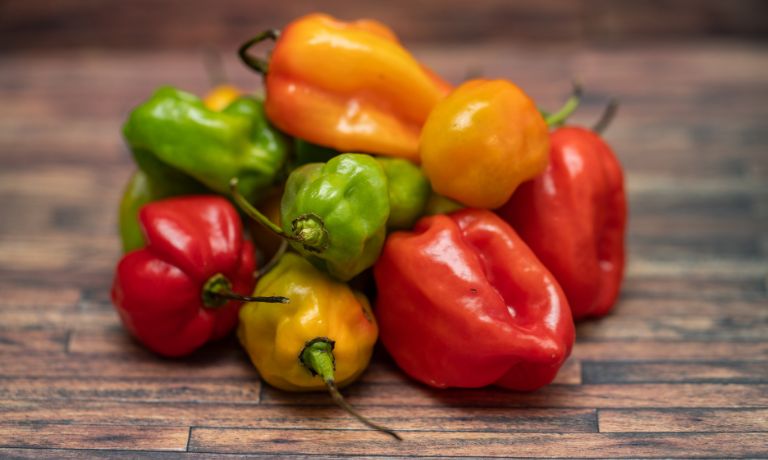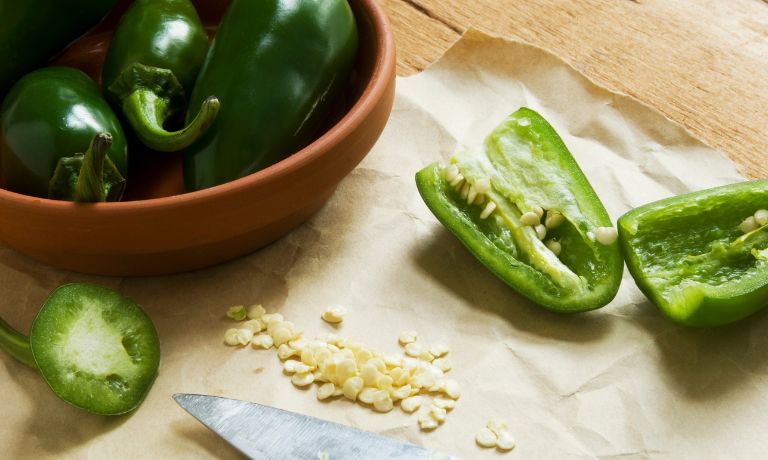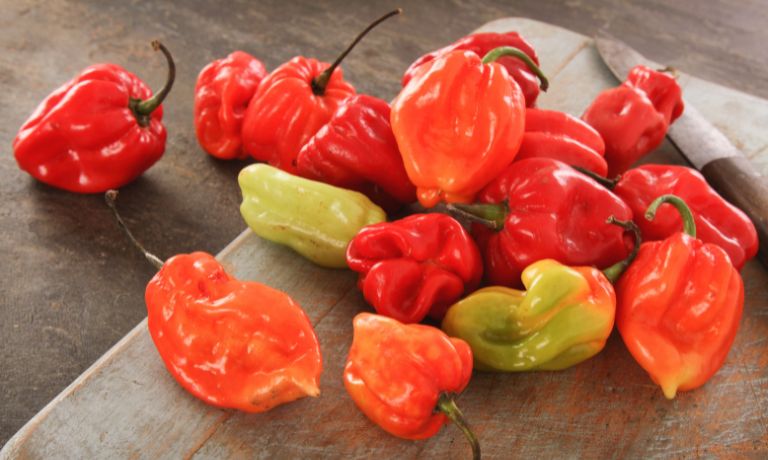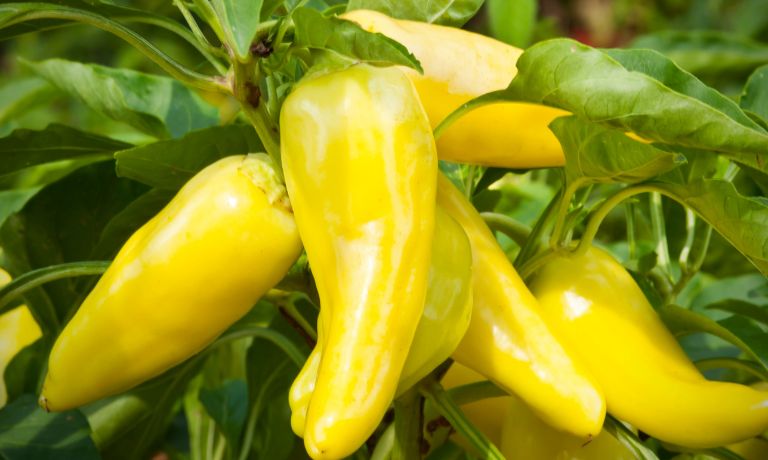Are you looking for a pepper to add heat and flavor to your dishes that is more manageable than the habanero pepper?
Habanero peppers are among the spiciest of peppers, so if you prefer something more subtle but still flavorful, there are various alternatives out there.
In this blog post, we’ll discuss some great substitutes for habanero pepper that offer similar flavors without the same level of intense spiciness.
What Is A Habanero Pepper?
Habanero peppers are a type of pepper known for their intense heat and fruity flavor.
Native to the Americas and Caribbean, habaneros are one of the hottest chili peppers on the Scoville scale, measuring up to 350,000 units.
They have a unique flavor profile which is both sweet and smoky with an underlying tropical fruitiness.
Habanero peppers are used in hot sauces, salsas, marinades and various dishes around the world.
With its high levels of capsaicin, habanero peppers can cause extreme spiciness when consumed raw or cooked.
However, their fiery heat can also add a depth of flavor to any recipe if used properly.
To use these peppers safely in your cooking, it is important to know how much heat they can impart and adjust recipes accordingly.
With their unique taste and intense heat, habanero peppers are an excellent choice for adding a flavorful kick to any cuisine.

Substitutes For Habanero Pepper
When it comes to adding some serious heat to a dish, the habanero pepper is an undisputed champion.
Native to the Americas and the Caribbean, this chili pepper packs some serious punch with its unique flavor profile and intense spice level.
Unfortunately, due to their rarity in some parts of the world, habanero peppers may not always be available for use in recipes.
In these cases, cooks must find substitutes that offer similar levels of heat and taste.
Jalapeño Peppers
Jalapeño peppers are one of the more popular substitutes for habanero pepper.
They have a similar earthy, vegetal flavor with less heat. Jalapeño peppers range from 2,500 to 8,000 on the Scoville scale (which measures spiciness).
This is relatively mild compared to Habanero’s 100,000 to 350,000 Scoville units.
Jalapeño peppers are a great option for those who want a more subtle, mellow heat.
Moreover, they’re easily available, affordable, and a great alternative for any recipe that calls for habanero pepper.

Cayenne Peppers
Cayenne peppers are another excellent alternative to habanero pepper.
They’re hotter than jalapeño peppers, but much milder than habanero.
They have a similar pungent, smoky flavor with a mild sweet taste.
[display-posts id=”2721″ image_size=”thumbnail” posts_per_page=”1″]
With a range of 30,000 to 50,000 Scoville units, they provide a medium level of spice that adds the perfect kick to any dish.
Additionally, cayenne pepper is easy to find in the spice aisle of any grocery store.
You can use cayenne pepper to spice up your sauce, chili, marinade, and any other dish that calls for habanero.

Scotch Bonnet Peppers
Scotch bonnet peppers are quite similar to habanero in terms of heat but with a sweeter flavor.
Their Scoville Unit varies between 100,000 to 350,000 which exactly matches the range of habanero pepper.
You can find them in Caribbean, Jamaican, and African markets, and sometimes in specialty food stores or online.
Scotch Bonnet Peppers are ideal for any recipe that requires habanero pepper, especially if you’re looking for a Caribbean flavor.
They are perfect for stews, soups, and jerk dishes.

Thai Chili Peppers
Thai Chili Peppers, also known as Bird’s Eye Chili, are popular in many Southeast Asian cuisines.
They are potent, with a Scoville range from 50,000 to 100,000 units, less than habanero pepper but more than jalapeño and cayenne.
[display-posts id=”2638″ image_size=”thumbnail” posts_per_page=”1″]
They have a bright, acidic flavor with a hint of sweetness.
Thai Chili Peppers are an excellent substitute for habanero pepper, particularly for dishes that need a more intense heat.
You can use them in curries, stir-fries, and chili sauce or paste. They are widely available in Asian stores or online.

Serrano Peppers
Serrano peppers are a great substitute for habanero peppers due to their similar look and heat levels.
They are moderately hot, about 5,000 to 23,000 Scoville units, which is less spicy than habanero peppers.
However, they still deliver a pleasant kick of heat and provide a fresh, crisp flavor.
They are commonly used in Mexican, Thai, and Vietnamese diets, making them somewhat of a versatile choice.

Rocotillo Peppers
Rocotillo peppers are native to South America and are a popular choice in Peruvian cuisine.
They are less hot than the habanero pepper, only registering about 1,500-2,500 on the Scoville scale.
They have a vibrant, fruity taste, and are great at lending depth to a dish, without the overpowering heat of a habanero pepper.
Banana Peppers
Despite being a common pickling choice, banana peppers are also a good cayenne pepper substitute with their delicately spicy tasting notes.
They have a Scoville rating of 1000 to 1500 which makes them considerably less spicy than habaneros.
These peppers provide a tangy, milder flavor and are perfect for adding to sandwiches, salads, or pizza.

Datil Peppers
Datil peppers have a similar heat level to Habaneros, making them a good substitute.
This type of pepper comes from the Gulf Coast of Florida, and it’s typically used to add a sweet citrus flavor to sauces, salsas, and marinades.
[display-posts id=”2510″ image_size=”thumbnail” posts_per_page=”1″]
They have a Scoville rating of 100,000 to 300,000, which is spicier than habaneros, providing a unique experience in spiciness and taste.
Chipotle Peppers
Chipotle peppers are a classic and popular substitute for habanero peppers as they impart a smoky intense taste that can be blended into a sauce or marinade.
These peppers are from the same plant family as habaneros, which is why they have a similar level of heat, about 2,500 to 8,000 Scoville units.
These peppers give a depth of smokiness to dishes, which you may not experience with habaneros.

FAQs
What Is The Scoville Rating Of Substitute Peppers?
Habanero peppers typically have a rating of 100,000-350,000 Scoville units while jalapeño peppers usually range from 2,500 to 8,000 Scoville units.
Poblanos are significantly milder with a rating of only 1,000-2,000 Scoville units.
This makes them an ideal choice for those wanting less heat but still want the flavor.
[display-posts id=”2042″ image_size=”thumbnail” posts_per_page=”1″]
What Is The Best Way To Prepare Substitute Peppers?
The best way to prepare substitute peppers depends on the dish you are making.
Most often, they can be diced or sliced and added to a recipe raw.
However, roasting them will bring out their natural smoky flavor and can add an extra layer of depth to dishes.
If you prefer less heat, blanching the peppers can reduce their spiciness before adding them to recipes.
Additionally, pureeing these peppers is a great way to make flavorful sauces or marinades!
Try experimenting with different techniques for the perfect flavor combination!
Can You Freeze Substitute Peppers?
Yes, you can freeze substitute peppers.
It is best to blanch them first in boiling water for two minutes and then shock them in an ice bath before freezing.
This will help preserve their flavor and texture.
For optimal results, it is recommended to thaw the peppers slowly in the refrigerator overnight before incorporating them into your dishes.
Alternatively, you can bring them back to room temperature before use. Either method ensures the best flavor and texture.
Freezing these peppers is a great way to make sure you always have some on hand for adding flavor and spice to your meals!
Conclusion
In conclusion, there are some great alternatives to the habanero pepper.
Each of these options can provide a similar level of heat and a unique flavor that can be used as a successful stand-in for the traditional habanero.
Depending on the dish you are making, one may be better than another so do some research and experimentation before settling on an ideal substitute.

